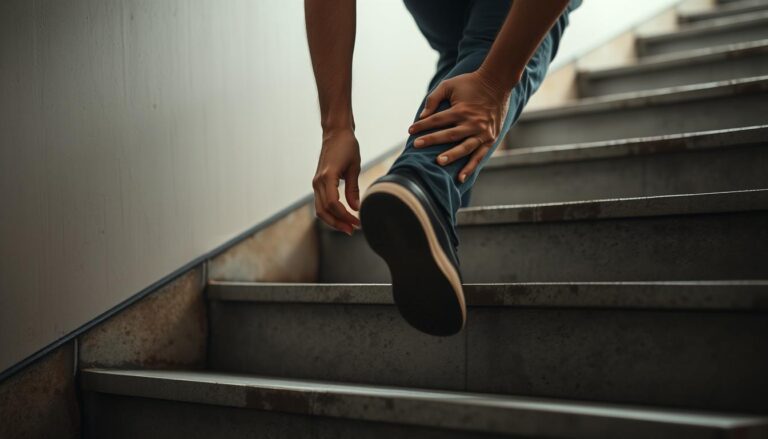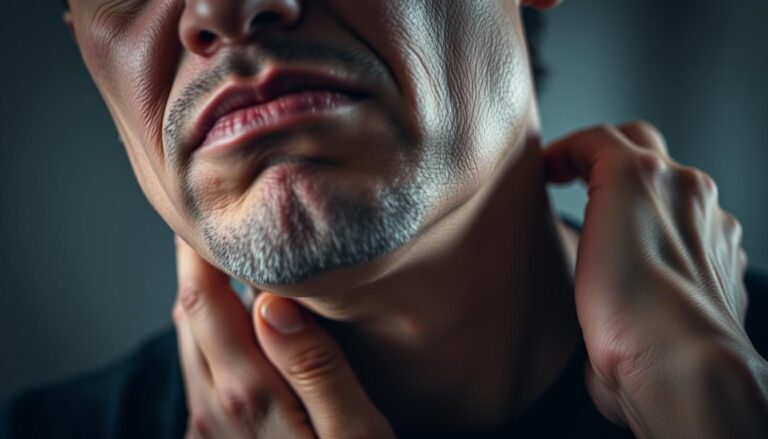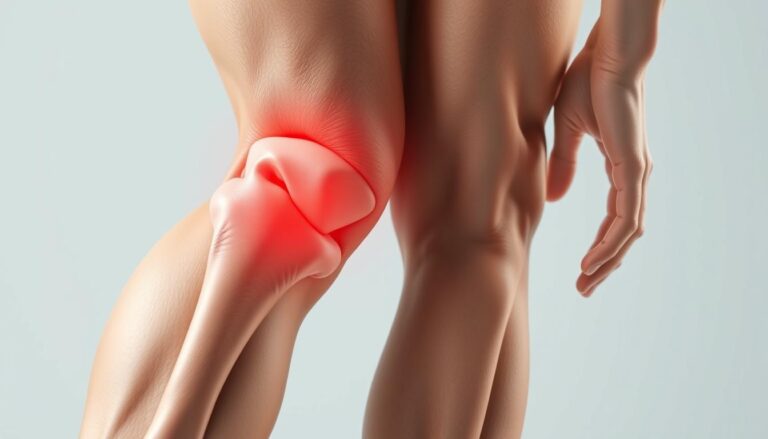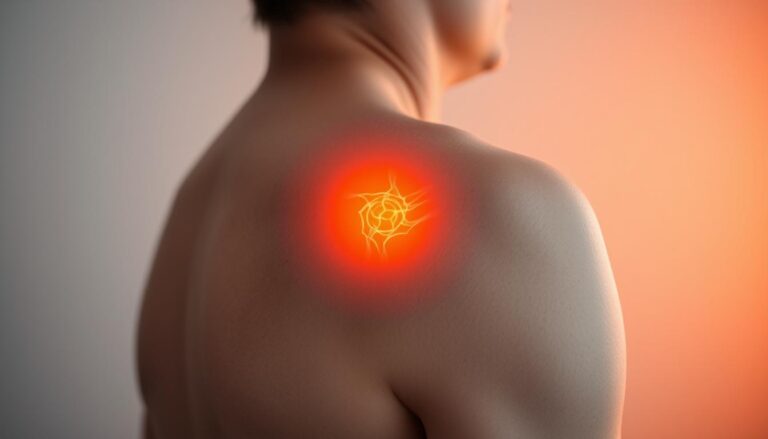What Are Muscle Knots & How To Get Rid of Them?
Muscle knots, also known as myofascial trigger points, are tight, sensitive areas in muscles or fascia. They can feel like small lumps or tight bands under the skin. These knots often cause aching, throbbing, and stiffness that restricts movement.
Experts like Tim Charleston, PT, DPT, and Michael Dakkak, DO, describe these knots as localized muscle contractions. These contractions can block blood flow and lead to waste buildup. John Gallucci, DPT, notes that intense knots can strain nearby tissues or even cause small tears or bleeding.
Many knots can be relieved with simple methods: gentle movement, staying hydrated, stretching, applying heat, and self-massage. For persistent or severe symptoms, physical therapy, dry needling, trigger-point injections, or medical imaging may be necessary. The treatment options range from home remedies to professional interventions, based on the severity and cause of the knots.
Key Takeaways
- Muscle knots are localized tight spots in muscle or fascia that cause pain and reduced motion.
- Experts link knots to sustained contractions that reduce blood flow and trap waste products.
- Common muscle knot causes include overuse, poor posture, stress, and dehydration.
- First‑line muscle knot relief: movement, hydration, heat, stretching, and self‑massage.
- Persistent knots may need professional muscle knot treatment like physical therapy or injections.
What Are Muscle Knots
Muscle knots are tight, often painful spots in muscles or fascia. They are known as myofascial trigger points. This term links everyday pain to a specific, testable concept.
Medical Definition And Terminology
In medical terms, myofascial trigger points are hyperirritable spots within a taut muscle band. A healthcare professional will press the area to check for tenderness and a palpable nodule. Ultrasound might show a tight band, but diagnosis is mainly clinical.
Active Versus Latent Trigger Points
Active trigger points cause pain even when not moving. This pain can disrupt sleep and daily activities. Latent trigger points only become apparent with pressure. Pressing them causes local tenderness and can send pain elsewhere, helping identify referred pain.
What A Knot Feels And Looks Like
People describe knots as pea-sized nodules or tight ropes in muscles. They feel aching, throbbing, stiffness, reduced range of motion, weakness, and sharp tenderness.
Tense fibers can narrow blood flow, leading to metabolic waste buildup. This can cause spasms, tiny tears, or fibrous changes over time. These mechanisms explain many muscle knot symptoms and why some knots are hard to treat.
Clinicians call knots “great mimickers” because they can mimic radicular pain, joint problems, or other conditions. Understanding muscle knot causes and symptoms helps narrow down diagnosis and guide treatment.
Common Causes Of Muscle Knots And Muscle Knot Causes
Muscle knots arise from various sources. Repetitive tasks at work or in sports are common culprits. Long hours at a desk or poor sleep positions also contribute. Additionally, acute strains or periods of inactivity can trigger them. These factors highlight why a single solution rarely addresses all cases.
Overuse And Repetitive Motion
Repetitive actions in sports, factory work, or exercise stress small muscle fibers. Over time, microtears and tight bands develop. The Cinderella fibers hypothesis explains this, where tiny motor units fire continuously while larger ones rest. This imbalance can lead to trigger points and classic overuse injuries.
Poor Posture And Prolonged Positions
Sitting with a rounded back, craning the neck toward a screen, or sleeping with a bad pillow keeps muscles tense for hours. This sustained tension causes fibers to stick together and lose their glide. Desk ergonomics and micro-breaks are crucial because lack of movement often leads to knots.
Stress, Fatigue, Hydration, And Nutrition
Emotional stress increases muscle tension and primes tissues for knots. Poor sleep and fatigue slow down repair and increase risk. Dehydration and muscle knots often appear together. Without enough fluid, cramps and spasms become more likely. Low protein or missing anti-inflammatory nutrients also slow healing.
Direct Injury And Inactivity
Acute strains, sudden twists, and heavy lifting can create localized trigger points. Extended bed rest or underuse produces a different problem: muscles lose strength and coordination. Both overuse and disuse act as muscle knot causes, so the same person may get knots from training too hard or sitting too long.
Practical implications are simple: balance workload with recovery. Treat training plans, desk setups, sleep habits, and hydration as parts of the same system. This broader view helps reduce repeat episodes and keeps tissues resilient.
Where Muscle Knots Develop And Muscle Knot Symptoms
Muscle knots follow predictable patterns but can surprise with unexpected referrals. This section outlines common locations, the sensations they cause, and red flags for deeper issues.
Common Locations
Knots often form where muscles bear load or stay tightened for long periods. Expect them in the neck, shoulders, and upper back near the shoulder blades.
Lower back knots and those along the iliotibial band are common in runners and cyclists. IT band knots typically sit on the outside of the thigh. Calves and shins can tighten after long standing or hill work.
Associated Symptoms And Referred Pain
Typical symptoms start with a local tender spot that feels like a tight band or small nodule. Pressure produces sharp point pain or a deep ache.
Range of motion may drop in the nearby joint. Muscles around the knot can seem weak or tired. Trigger points sometimes send pain to other areas, so a shoulder knot may cause headaches or arm pain.
When They May Indicate A Bigger Problem
Most knots are harmless and respond to self-care. Seek medical attention for persistent or worsening pain that does not improve with rest and conservative measures.
Red flags include a growing, visible lump, skin redness, warmth, fever, drainage, or pain that steals sleep. These signs can point to infection, cysts, tumors, or joint and nerve pathology such as radiculopathy.
Clinicians may look for a twitch response during exam. Atypical features or systemic signs often prompt imaging like ultrasound or MRI and referral for physical therapy or specialist care.
At-Home Muscle Knot Relief And First-Line Muscle Knot Treatment
Everyday aches can be managed with simple steps focusing on circulation, soothing, and consistent care. Begin with light movement and conclude with gentle stretches to alleviate tight spots. Below is a concise routine for at-home muscle knot treatment.
Movement and short aerobic activities increase heart rate and oxygen delivery to tense tissues. A brisk five- to ten-minute walk, cycling on a light setting, or active range-of-motion drills for the neck and shoulders help fibers release. Avoid immobilization, as it tends to worsen trigger points. Instead, prioritize regular, painless motion over complete rest.
Hydration is crucial for muscle knots. Water supports muscle metabolism and aids in clearing metabolic byproducts that contribute to soreness. Combine fluids with whole-grain carbs, lean proteins, and anti-inflammatory foods like blueberries, salmon, and spinach to enhance recovery and muscle knot relief.
For established knots, moist heat for 15–20 minutes relaxes tissue and opens local blood vessels. Cold packs are best for fresh injuries to limit swelling. Contrast therapy — brief alternation between warm and cold — can be effective depending on timing and symptoms. Use heat before stretching, and cold after aggressive activity.
Stretching and gentle mobilization should be short and regular. Focus on the neck, shoulders, upper back, hips, and hamstrings with slow, controlled moves. Micro-breaks at the desk and a brief bedtime routine help form habits that reduce recurrence and teach how to prevent muscle knots.
A practical sequence includes: hydrate, move to get blood flowing, apply heat if the knot is not acute, then add light stretching and modest self-massage. If pain worsens or fails to improve after a few sessions, seek a clinician’s assessment for tailored care beyond at-home muscle knot treatment.
| Step | Action | Why It Helps |
|---|---|---|
| 1 | Hydrate (water, electrolytes) | Improves circulation and metabolic clearance; essential hydration for muscle knots |
| 2 | Light cardio or active warm-up (5–10 min) | Raises heart rate and increases blood flow to tight muscles for quicker muscle knot relief |
| 3 | Moist heat (15–20 min) if not acute | Relaxes soft tissue and prepares muscle for stretching |
| 4 | Gentle stretching and joint mobilization | Restores range of motion and reduces trigger point tension |
| 5 | Short self-massage or foam rolling, moderate pressure | Promotes local blood flow and eases tight bands without causing bruising |
| 6 | Routine micro-breaks and sleep-time stretches | Builds habits that help how to prevent muscle knots over weeks |
Self-Massage, Tools, And Muscle Knot Massage Techniques
Hands-on work can ease a tight spot fast. Gentle, focused pressure helps the muscle relax and restores blood flow. Use slow strokes and brief holds before moving the joint through a comfortable range.
Manual Trigger Point Pressure
Apply moderate, steady pressure directly on the tender point until the ache eases. Press to tolerance, not to sharp pain. Hold for 20–60 seconds, release, then follow with gentle stretching and a few range-of-motion moves.
Avoid pressing over bone, the spine, or swollen tissue. If numbness or pins-and-needles appear, stop and get a professional opinion.
Foam Rollers, Massage Balls, And Percussion Devices
Pick the right tool for the area. A foam roller for knots suits large muscles like the back and hamstrings. Massage balls target small spots in the shoulder and neck. Percussion devices need careful use; start low and short.
- Use a foam roller for knots with slow, controlled rolls. Stop on tender spots and breathe into the release.
- Massage balls work best against a wall or floor to limit pressure and protect the neck.
- Follow basic massage gun tips: use a soft head, low speed, and 10–20 second bursts at first. Gradually build toward about a minute on one area if it feels helpful.
When Self-Massage Can Backfire
Too much force can inflame a knot and spread pain. Deep, aggressive work on hot, swollen, or recently injured tissue may make things worse. Pain that grows, spreads, or brings tingling needs a clinician’s check.
Stop if self-massage for muscle knots increases sharp pain or causes numbness. Seek physical therapy or a licensed massage therapist for persistent problems rather than pushing harder alone.
Professional Treatments And Muscle Knot Therapy
When home remedies don’t work, professionals step in with targeted strategies. They use hands-on techniques, specific exercises, and procedures to tackle pain and restore movement. The choice of treatment depends on the severity, response to previous care, and daily functioning.
Physical Therapy Approaches
Physical therapists employ therapeutic massage and myofascial release to soften tight bands and enhance tissue mobility. They also teach exercises that build strength and endurance for long-term benefits.
They focus on scapular stabilization, posture correction, and movement retraining to reduce strain. This helps prevent recurring knots. Therapists also provide home exercises to help patients manage their condition between visits.
Procedural Options
Clinicians may suggest in-office treatments for persistent knots. Dry needling involves using thin needles to stimulate trigger points and reduce tension.
Trigger point injections use local anesthetics or Botox to alleviate chronic knots and quiet pain sources. Extracorporeal shock wave therapy is considered for persistent spots that don’t respond to other treatments.
Modalities And Adjuncts
Adjunct therapies aim to enhance recovery and alleviate symptoms. Low-level laser therapy and pulsed ultrasound promote tissue healing and circulation. TENS and electrostimulation offer temporary pain relief without medication.
Mechanical vibration and spray-and-stretch techniques help loosen tight muscle fibers before exercise. Short-term use of NSAIDs or muscle relaxants can help with acute pain. In some cases, certain antidepressants are considered for chronic pain management.
If conservative measures don’t work, the treatment path may shift from physical therapy to more invasive procedures or imaging. Decisions are based on symptom severity, lost function, and the need to rule out other conditions.
Prevention Strategies And How To Prevent Muscle Knots
Preventing muscle knots requires simple setup changes, steady movement, calm habits, and smart recovery. Making small daily choices can significantly impact your health. The goal is to find practical prevention methods that fit into your busy schedule.
Ergonomics And Posture Optimization
Start with a workspace that supports neutral alignment. Position your screen at eye level and keep your keyboard where your forearms are parallel to the floor. Use an adjustable chair with good lumbar support and a headrest when available.
Adjust your keyboard height or use a wrist rest to avoid shoulder strain. Take posture checks every hour and switch from static positions to brief movements. These adjustments are crucial for preventing muscle knots by reducing tension.
Regular Movement And Targeted Exercise
Combine cardio, mobility drills, and strength training to avoid overusing small muscle fibers. Include exercises that strengthen the scapula and improve thoracic extension to protect your neck and shoulders. Short, daily workouts are more effective than long, sporadic ones.
Integrate micro-breaks into your day, such as standing, walking, and dynamic stretching every 30–60 minutes. A weekly “exercise happy hour” focused on mobility can keep muscles resilient and prevent knots.
Stress Management And Sleep Hygiene
Chronic tension can tighten muscles overnight. Techniques like deep breathing, brief mindfulness, or progressive relaxation can help. Pair stretches with nightly routines, like brushing teeth, to solidify prevention habits.
Aim for consistent sleep timing and aim for seven to nine hours when possible. Rested muscles recover faster and are less prone to persistent tight spots.
Hydration, Nutrition, And Recovery Habits
Stay hydrated and eat balanced meals with lean protein and anti-inflammatory foods to support muscle repair. Gradually increase training intensity and include planned rest days to avoid overloading muscles.
Recovery habits like contrast baths, gentle foam rolling, and quality sleep are essential. These practices form a comprehensive plan to prevent muscle knots while maintaining performance.
Quick Practical Routine
- Every 45 minutes: stand, walk 60 seconds, and do a thoracic rotation.
- Daily: 10 minutes of mobility focused on shoulders and upper back.
- Weekly: two short strength sessions that include scapular pulls and rows.
- Nightly: one calming breath practice and a short stretch before bed.
When To See A Doctor And Warning Signs
Muscle knots often resolve with rest, stretching, and self-care. However, certain signs warrant a medical visit. This guide helps differentiate between harmless tightness and serious issues that require immediate attention.
Red Flags Requiring Medical Evaluation
Seek medical evaluation if pain persists or worsens despite home remedies. Night pain, loss of daily function, or a growing lump under the skin are red flags. These symptoms indicate a need for professional evaluation.
Signs of infection, such as redness, warmth, fever, and pus drainage, require urgent medical attention. These symptoms suggest a condition beyond a simple muscle knot and necessitate timely testing.
What Clinicians Might Do
Clinicians begin with a detailed physical exam to identify tender points and assess twitch responses. They compare these findings to the typical pattern of a trigger point.
If the symptoms are unusual, imaging like ultrasound or MRI might be ordered. Lab tests are considered if infection is suspected. Based on initial findings, referrals to physical therapists, neurologists, or orthopedic specialists may occur.
Conditions That Can Mimic Trigger Points
Many conditions can mimic muscle knots. Radiculopathy, caused by nerve root compression, can produce pain and weakness similar to a muscle knot. Joint issues, cysts, tumors, and superficial infections also present similarly.
Accurate differential diagnosis is crucial to avoid inappropriate treatments. Distinguishing between radiculopathy and trigger points is important because their treatments differ. Nerve decompression or spine care are needed for radiculopathy, while trigger points may require targeted injections or manual therapy.
Any knot with systemic signs or progressive changes should not be dismissed as benign. Timely evaluation prevents missing serious conditions and ensures safe, effective treatment.
| Concern | Key Clues | Likely Next Steps |
|---|---|---|
| Infection | Redness, warmth, fever, drainage | Blood tests, ultrasound, antibiotics, possible drainage |
| Suspicious Mass | Visible or growing lump under skin | Ultrasound or MRI, referral to surgery or oncology |
| Nerve Root Compression | Radiating pain, numbness, weakness | Neurologic exam, MRI of spine, electrodiagnostic testing |
| Trigger Point | Focal tender band, local twitch response | Manual therapy, dry needling, trigger point injections, physical therapy |
Exercises And Routines For Lasting Muscle Knot Relief And Muscle Knot Exercises
Begin with simple exercises that boost blood flow and ease tight spots. The most effective routines combine gentle stretching, mobility exercises, and light strengthening. It’s crucial to stretch without pain and build endurance to prevent knots from returning.
Neck Mobility And Scapular Strength
Start with chin tucks and slow neck rotations to restore neutral alignment. Pair each hold with steady breathing and never push into sharp pain.
Scapular retractions and wall slides train the shoulder blades to support the neck. These moves reduce overload on upper trapezius and levator scapulae muscles.
Include targeted thoracic extension exercises to open the chest and ease forward-head strain. A few reps against a foam roller or seated chest-opening drills improve posture quickly.
Back, Hips, And Lower Limb Flow
Thoracic mobility drills set the foundation for a healthy spine. Gentle foam-roller rotations help shift stiffness away from the neck and shoulders.
Follow with hamstring and calf stretches to reduce pull on the pelvis. Tight legs often force the lower back and hips to compensate, creating upstream tension.
Glute bridges and clamshells build hip endurance so walking and standing do not feed muscle knots. Add IT band mobility with controlled side-lying stretches or a massage ball.
Sample Micro-Break And Desk Routine
Every 30–60 minutes stand and move for two to five minutes. March in place or walk to reset circulation and unload static muscles.
- Shoulder circles: 10 slow reps each direction.
- Gentle thoracic twists: 8–10 per side while seated.
- Quick neck stretch: tilt ear to shoulder, hold 10–15 seconds, repeat twice per side.
Once daily add a 15-minute targeted session combining neck and shoulder stretches, thoracic extension exercises, and light strengthening. That brief “happy hour” prevents stiffness and reduces the urge to overwork sore spots.
Progress gradually. Increase intensity only when movements feel controlled. Avoid painful end-range holds and seek a physical therapist for recurring knots that limit daily tasks.
| Goal | Exercise Examples | Duration / Reps |
|---|---|---|
| Improve Neck Mobility | Chin tucks, slow neck rotations | 10–15 seconds holds, 8–12 reps |
| Stabilize Shoulders | Scapular retractions, wall slides | 2–3 sets of 8–12 reps |
| Open Thoracic Spine | Foam roller extensions, seated chest-openers | 30–60 seconds, 3 rounds |
| Release Lower Chain | Hamstring and calf stretches, IT band mobility | 30 seconds each, 2–3 reps per side |
| Build Hip Strength | Glute bridges, clamshells | 2–3 sets of 10–15 reps |
| Desk Prevention | Short march, shoulder circles: desk routine for muscle knots | Every 30–60 minutes, 2–5 minutes |
Conclusion
Muscle knots are small, tense areas within muscles, often caused by repetitive activities, poor posture, or stress. Understanding muscle knots can help alleviate the discomfort they bring. They typically respond well to gentle movements, hydration, heat, and simple stretches.
Relieving muscle knots requires a consistent approach. Engage in targeted exercises, take regular breaks, and prioritize sleep and hydration. Improving posture and managing stress are also crucial. Most knots can be resolved with these measures. However, if the pain persists, seeking professional help may be necessary.
Viewing muscle knots as temporary issues can help manage them effectively. By maintaining a balance between activity and rest, and focusing on recovery, you can prevent muscle knots. This approach ensures a smoother daily life.
FAQ
What Exactly Are Muscle Knots?
Muscle knots, also known as myofascial trigger points, are tight, sensitive spots in muscles or fascia. They can feel like small nodules or tight bands under the skin. These areas cause pain, stiffness, and limit movement. They are like localized muscle contractions that can restrict blood flow and lead to tissue strain or microtears.
How Do Active And Latent Trigger Points Differ?
Active trigger points cause pain even when you’re not moving. Latent trigger points don’t hurt unless pressed, but they can still limit movement and cause pain when touched. Active points are more likely to disrupt daily activities and sleep.
What Do Muscle Knots Feel And Look Like?
Muscle knots can feel like small bumps or tight bands. They are not always visible, but you might feel a firm nodule or tightness. If you see redness, warmth, or swelling, it could be something else and needs medical attention.
What Common Activities Cause Muscle Knots?
Muscle knots can be caused by overuse, repetitive motions, and poor posture. Mental stress, dehydration, and inadequate nutrition also play a role. Even prolonged inactivity can trigger knots. It’s common for the same person to experience knots from both too little and too much movement.
Where Do Muscle Knots Most Often Develop?
Muscle knots often occur in the neck, shoulders, back, thighs, calves, and shins. Any muscle or fascial sheet under tension or repetitive load can develop trigger points.
What Symptoms Suggest A Knot Is More Than Just A Knot?
Red flags include persistent pain, a growing mass, redness, warmth, fever, or drainage. Numbness, weakness, or pain that prevents sleep also indicate a need for medical evaluation. These signs could point to infections, cysts, tumors, or nerve problems.
What Should Be The First Steps For At‑Home Muscle Knot Relief?
Start by hydrating and moving to improve circulation. Apply moist heat for 15–20 minutes if the issue is not acute. Then, do gentle stretching and self-massage. Short breaks and regular movement are better than long holds. Stop any action that increases pain or numbness.
How Do You Self‑Massage A Knot Safely?
Use moderate pressure on the tender spot for short intervals. Follow with gentle stretching and movement. Foam rollers and massage balls are good for large and small areas. Use slow, controlled pressure and long strokes to keep blood flowing.
When Can Self‑Massage Make Things Worse?
Deep-tissue work can worsen inflammation, especially over bony areas or inflamed tissue. If self-massage increases pain, numbness, or tingling, stop and seek professional help.
What Professional Treatments And Muscle Knot Therapy Options Exist?
Physical therapy includes massage, myofascial release, and corrective exercises. Procedural options include dry needling and trigger-point injections. Other treatments include TENS, low-level laser, and pulsed ultrasound. Medications like NSAIDs or muscle relaxants can help in the short term.
How Do Clinicians Diagnose And Assess Trigger Points?
Diagnosis is clinical, based on point tenderness and palpable tight bands. Ultrasound can sometimes show tight bands. MRI or other imaging is used for atypical findings. If there are systemic signs, imaging or lab tests may be ordered.
How Can Muscle Knots Be Prevented?
Prevention involves ergonomics, movement variety, hydration, nutrition, and stress management. Set up workstations for neutral posture and take breaks every 30–60 minutes. Combine cardio, mobility, and strengthening exercises. Prioritize sleep and fuel with lean protein and anti-inflammatory foods. Gradual training and planned rest days reduce overuse risk.
What Exercises Help For Lasting Muscle Knot Relief?
Neck and shoulder routines include chin tucks and scapular retractions. Back, hip, and lower-limb exercises include thoracic mobility and hamstring stretches. A simple micro-break routine—stand, march in place, shoulder circles, and neck stretches—can significantly reduce recurrence.




